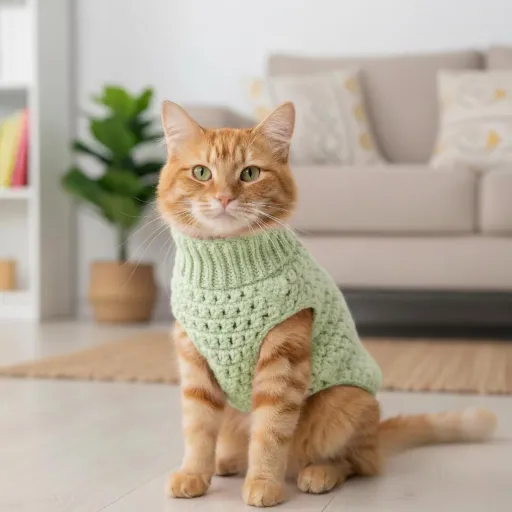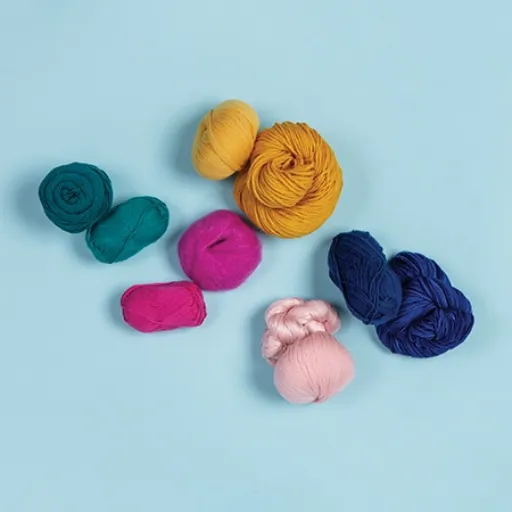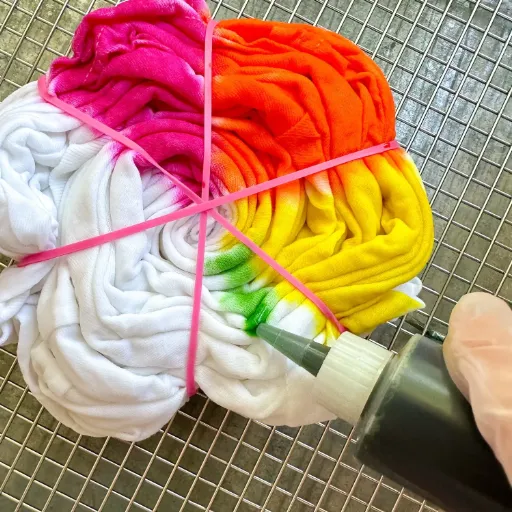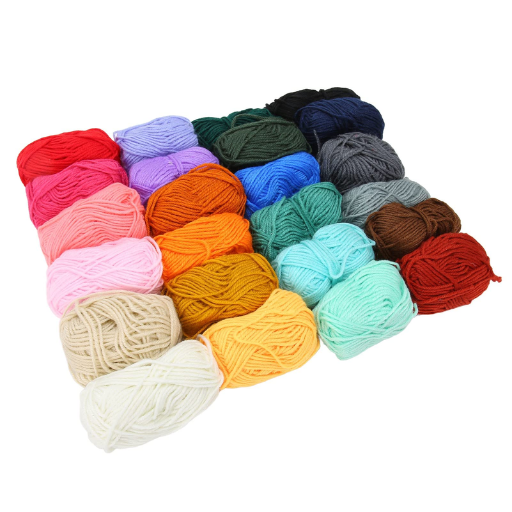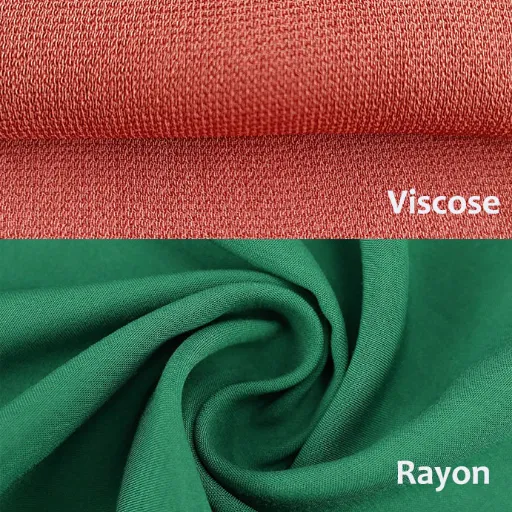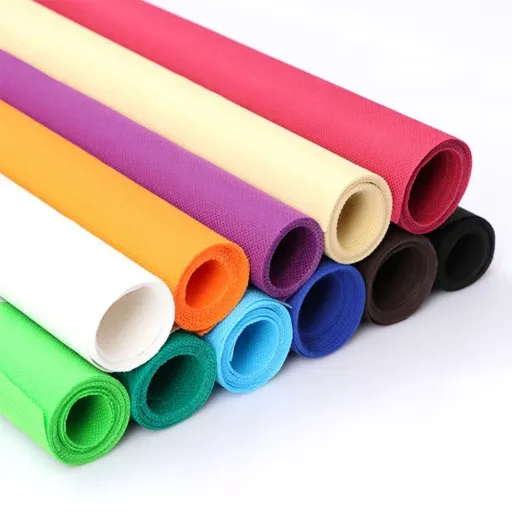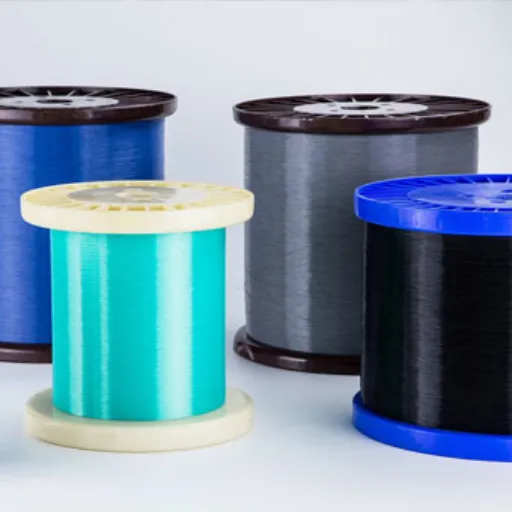The world of textiles is filled with thousands of magnificent fiber possibilities, and rayon and viscose fabrics have thus become household names due to their great versatility, softness, and better-than-average affordability. So, what are these fabrics actually, and how are they different? Whenever you go out looking for garments, interior decorations, or craft materials, a clear knowledge of what rayon and viscose are will greatly assist you in making informed decisions. This guide takes the reader deep into the intriguing world of these semi-synthetic fabrics, discussing their origin, unique properties, and the benefits. It takes you through the entire production process and onward to the practical tips for maintaining them, thus providing you with everything you need to know to appreciate fully and apply rayon and viscose in your day-to-day life.
Introduction to Viscose and Rayon

Defining Viscose and Rayon
Viscose and rayon-the two terms for a variety of materials around cellulose fibers originating from natural sources such as wood pulp and cotton-those in common usage are just a bit grayer from one another. Basically, rayon applies to all fibers and fabrics made from regenerated cellulose, of which viscose is just one kind. Viscose refers specifically to a type of rayon produced by chemically converting cellulose into a semi-synthetic fiber.
Cellulose of natural origin is broken down into its basic form and chemically worked upon to yield a solution capable of being spun into very fine fibers. This process renders viscose and rayon a great alternative to silk as they share silk’s luxurious texture without having to undergo the direct cost. The two fabrics are soft, lightweight, and breathable, popular choices for clothing and upholstery, among other applications.
Key Points: Since they are able to take pigments well and retain bright colors for a long time, both rayon and viscose are put to good use for dyeing purposes. However, they shrink quite easily and are relatively less durable than synthetic fibers, which is why one should always handle these fabrics with care. Nevertheless, their natural feel, versatility, and affordability keep them a favorite among textile makers.
The Importance of Rayon Fabrics
Rayon fabrics are important in the textile industry due to an interplay of several defining characteristics. A semi-synthetic fiber, rayon offers the cheapness and versatility of synthetics combined with the lightness and comfort of natural fibers; hence it is a balanced choice for multiple uses-from fine clothing to home textiles.
The main benefit of rayon lies in being breathable and moisture absorptive, making it an apt fabric for garments intended for warm weather and active wear. The fabric provides an inherently light feel which is similar to what would have been experienced by natural fibers such as cotton or silk. On the other hand, rayon accepts very bright dyes that make colorful and patterned cloths arisen in high demand in both fashion and interior decorating.
Hence rayon fabrics need extreme care since they have a tendency of shrinking and are less durable when compared to sole synthetic fabrics. Despite these factors, due to cheapness and adaptability, all still are a priority with manufacturers and consumers. In short, rayon delivers stylish apparel with comfort and functionality, making it eternal in securing a vital position in textiles today.
Overview of Viscose Fabric
Viscose fabric, also called rayon, is a structure that is semi-synthetic, being formed from cellulose obtained mostly from wood pulp. In terms of feel, viscose is a great option, as it is soft, airy, multifunctional, and similar to common collocations of natural fabric: cotton, silk, and wool. The production technique includes subjecting the cellulose to chemical treatment so that a viscous solution can be obtained and then it is spun into fibers and woven into a fabric.
One of the greatest merits of viscose is that it falls well and beautifully, amongst others, and therefore is widely used in manufacturing finery that is comfortable and easy to wear, such as dresses, tops, or scarves. In addition, viscose has good absorbability and hence can accept dyes well, retaining rich color for a long time; thus, it is also used for upholstery, at home, and industrial purposes.
Important Considerations: On the downside, it does have a few disadvantages. It shrinks and loses strength when it is wet, so careful washing and aftercare should be communicated. In the wake of environmentalism, production processes have been questioned since traditionally it emits a load of waste and chemical runoffs. But still, it is presently a fabric of choice due to the increased realization in environment-friendly production methods.
History of Viscose and Rayon
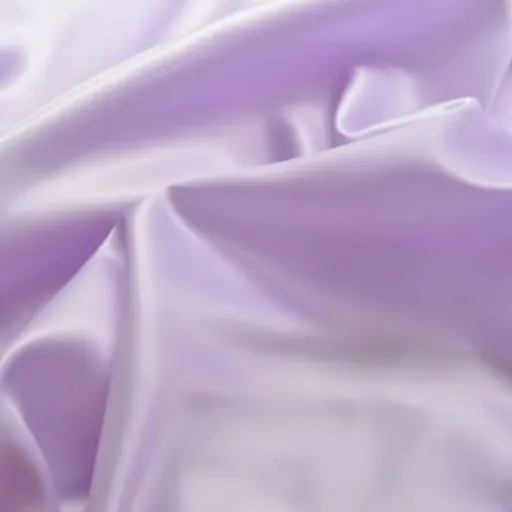
The Origins of Rayon
The imagery and philosophy surrounding textile matters are greatly influenced in countless ways by the history of rayon. Considered by some to be the first man-made fiber, rayon came into existence in the late nineteenth century. An attempt to create a silk substitute resulted in the origin of rayon: hence, the name. The earliest methods for making rayon were introduced by a French scientist, Hilaire de Chardonnet, in 1884. He chemically treated cellulose from vegetable raw materials, such as wood pulp, to produce a fiber that could simulate silk in texture and appearance. The first form of rayon was called “artificial silk”.
Throughout the early part of the 20th century, process improvements and refinements were introduced and perfected until eventually one of the most important ways of producing rayon was put to mass use by the introduction of the viscose method by Charles Cross, Edward Bevan, and Clayton Beadle in 1892. This particular method used a chemical process that converted cellulose into fibers in a much faster and reliable way. Soon after, the viscose method became the main commercial operation for producing rayon, thus making them very accessible for industrial and fashion applications.
Thus, creating rayon was a landmark with reference to the history of textile, which stands in between natural and synthetic fiber. Rayon has thus made its mark by ensuring the famous silk has direct industry competition and possibilities for fabric production and design. Currently, it enjoys great popularity due to its superior softness, fluidity, and plenty of alternatives for use that can trace back to something innovated over a hundred years ago.
Evolution of Viscose Production
In the early 20th century, viscose was produced in a hazardous and costly laboratory method: Cellulose fibers, derived mostly from wood pulp, were chemically treated and used as a fiber-yielding agent. That way, in the beginning, it involved all manual labor and hazardous chemicals that posed threats to safety and the environment, carbon disulfide being one of the glittering examples of these chemicals.
Gradually, the production techniques attained refinement, searched for efficiency, and tried to lessen environmental problems. More modern production techniques featured closed-loop systems, allowing chemicals to be recycled within the process, thereby minimizing the creation of wastes and pollution. The late 1980s witnessed such systems as a major move towards sustainability, therefore tackling issues related to chemical disposal and safety of workers. Further advances in filtration procedures enhanced the purification and consistent quality of the final fiber, allowing for ever broader applications.
Modern-day viscose production is continually evolving with sustainability taking greater prominence in its consideration. Hence, research is being promoted on alternative materials that would be environmentally safe, while further use would be of renewable resources and less harmful chemicals. Innovations consider lyocell as a newer, regenerated cellulose type-as a more environmentally correct alternative to viscose. This is precisely what brings out the textile industry’s desire to do justice to functionality while giving due respect to nature in the production of viscose.
Key Milestones in Rayon Fabric Development
- 1884: French chemist Hilaire de Chardonnet created “artificial silk” from cellulose derived from plant fibers, marking the birth of rayon. However, his process was very flammable, sparking further development.
- 1894: The viscose process was patented by Englishmen Charles Frederick Cross, Edward John Bevan, and Clayton Beadle, creating a more versatile and safer fiber production method.
- Early 1900s: Mass manufacture and distribution of viscose rayon began, starting a new textile era combining affordability with functionality.
- Modern Era: Development of lyocell and other eco-friendly rayon types, incorporating closed-loop processes with minimal environmental footprint.
The Production Process of Viscose Rayon
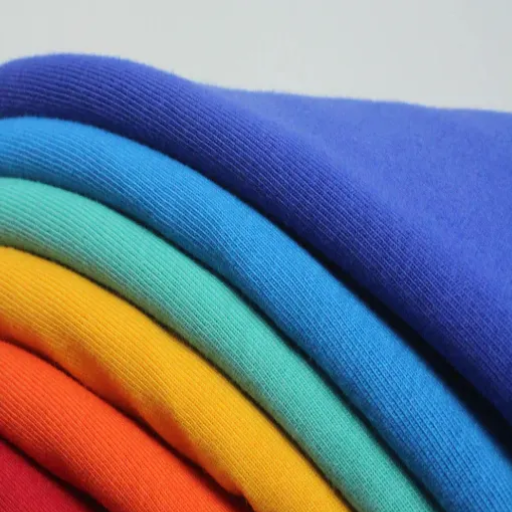
Raw Materials Used in Viscose Production
In the viscose industry, one natural raw material starts the production of viscose rayon: wood pulp from swiftly maturing trees such as eucalyptus, spruce, beech, or bamboo. These trees are grown to assure the environment and maintain a continuous supply of cellulose, which is basically what viscose needs for production. Hence, depending on such renewable resources plays a pivotal role in maintaining the balance between industries and environmental concerns.
The cellulose extracted from the wood pulp is treated chemically to make it useful for manufacturing rayon fibers. These treatments usually involve soaking the wood pulp in sodium hydroxide to form alkali cellulose, which is then aged, pressed, shredded, and treated with carbon disulfide to give cellulose xanthate. This intermediate is dissolved in a dilute sodium hydroxide solution to give the viscose solution. The quality of these materials and the filament characteristics are ensured under strict controls in all these processes.
Other auxiliary materials that take part in the process are water and chemical reagents such as sulfuric acid which helps the spinning process to solidify the viscose solution into fibers. Producers are concentrating on using chemicals in a more efficient way, through recycling and recovery systems, to lessen waste and the pollution load on environment. Using sustainable raw materials and making outputs and process efficiencies better, the production of viscose rayon is gearing toward more eco-friendly territory and still remains a versatile and welcomed textile material.
Step-by-Step Production of Viscose Fabric
- Preparation of Cellulose: The making of viscose fabric starts with the preparation of cellulose, usually from wood pulp or cotton linters. The raw cellulose matter is treated to bring out the pure cellulose, which is the basic process.
- Steeping and Pressing: The purified cellulose is steeped in a chemical solution, generally sodium hydroxide, to form alkali cellulose. This step softens the cellulose and also prepares it for further chemical treatment. The alkali cellulose is further pressed to expel excess liquid.
- Shredding and Aging: The cellulose is then carefully shredded into small pieces to increase their surface area. These shreds of cellulose undergo an aging process in controlled conditions that change their property to make them more easily soluble in the forthcoming steps.
- Xanthation: After aging, the cellulose is converted into cellulose xanthate by treatment with carbon disulfide. This is the most important step as it converts cellulose into a form that can be easily dissolved in the next stage.
- Dissolving: The cellulose xanthate is dissolved in a diluted sodium hydroxide solution to form a viscous viscose liquid. This solution is then filtered to remove impurities and allowed to undergo maturing for some time for gaining required properties.
- Spinning: The matured viscose liquid is extruded through the spinneret into a sodic bath of sulfuric acid and other chemicals. The polymeric liquid in the bath solidifies into continuous filaments which become the viscose fibers.
- Washing and Finishing: Just after being formed, the fibers undergo the process of washing to remove residual chemicals. They are then treated with softeners or finishes to improve texture, strength, and usability.
- Drying and Cutting: The fibers are dried and, if required, cut to certain lengths to form either staple fibers or left continuous for filament yarns. These fibers are then ready for weaving or knitting into fabric.
Innovations in Rayon Fabric Manufacturing
Recent developments in rayon production aim at sustainability, less environmental impact, and good quality. One innovative mechanism is the use of an environmentally friendly production technology. Such production usually involves heavy chemical usage; however, newer methods such as closed-loop systems have been put into place. These recycle and regenerate the solvents, thus greatly cutting down pollutants and waste.
Bio-based alternatives are brewing as a good alternative in rayon production. By using raw materials from renewable sources such as wood pulp of forests established on a sustainable yield basis and facilities that espouse greener technology, concerns regarding deforestation and depletion of resources are somehow addressed. These bio-based alternatives aspire toward a more sustainable rayon with good quality output.
Also, various advanced treatment methods have been developed to render the rayon fabric with added functionality and performance properties. Some of the treatments enhance the durability of the fabric and may, for example, improve the moisture adsorption of the fabric so that it meets the requirements of fashion and industrial applications. The presence of these technologies is a testimony of the ongoing development of rayon as a fabric for conscientious choice in an eco-friendly manner.
Properties of Viscose and Rayon Fabrics
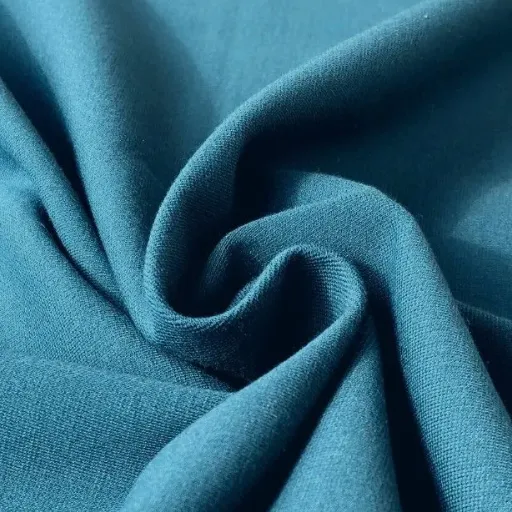
Physical Properties of Viscose Fabric
The viscose fabric flaunts a smooth and soft texture, quite similar to natural fibers such as cotton or silk. In view of this, it is worn in designs which call for ample comfort and aesthetics. It is sheer and breathable, which also promotes situational ease of wear under various climes, especially warmer ones.
Another physical aspect that characterizes viscose is its dive-worthy drape. Highly versatile as it is, this fabric cascades beautifully, making it perfect for designs to be hollow or cling onto the body. The semi-gloss finish inherent to this material only adds to that sheen and beauty of the drape.
Note: But, if one pursues perfection, viscose fabric does one bad-all wicked wrinkling!-and it is the weak nature of a fiber to which the elastics in the fabric do not resist with very shearing forces exerted upon them. It takes its dye very well and has brilliant colors that last, but when wet, the fabric is at its weakest and it almost becomes a hazard to dye. This means viscose looks really good on the outside but has to be cared for on the inside if it had to live up to its promise of beauty.
Comparative Analysis: Viscose vs Other Fabrics
| Property | Viscose | Cotton | Polyester |
|---|---|---|---|
| Softness | Silky soft, luxury feel | Natural softness | Synthetic touch |
| Breathability | Excellent air circulation | Good breathability | Traps heat |
| Durability | Delicate, loses strength when wet | Sturdy, handles wet/dry treatments | Highly durable |
| Environmental Impact | Chemical-laden production process | High water consumption, pesticides | Non-renewable resources, microplastics |
In terms of softness and luxury, viscose has therefore a place in front of other fabrics such as cotton and polyester. Polyester has a synthetic touch to it; viscose actually mimics in some respects the very feels of silky soft natural silk, hence its popularity in clothing that aims at a certain high-status appeal that cannot really be afforded. But then comes the weakness and the very hardness that shows through its softness: with time and moisture, viscose will lose strength. By that very remit, a cotton, being sturdier and able to stand dry or wet treatments, would be a more practical alternative.
The next commonly discussed difference between the fabrics is the breathability of fabric vis-a-vis polyester. Viscose gives better air circulation, which is why it is predominantly desired for summer wear or in areas of hot climate. Polyester is not the best in terms of breathability because it traps heat; it is, however, appreciated for sweating and wipe-resistant properties. In the case of cotton, again, really good in breathability, though maybe it may hold onto moisture a little more than viscose or polyester would and that would make for an inconvenience if not dried in time. From the environment point of view, viscose faces some issues. It is made out of natural cellulose, but the chemical-laden production process, if not carried out with all possible leads to having grave environmental consequences. While cotton is still natural, adverse consequences lie in huge water consumption and lots of pesticide types used on its cultivation. Polyester, being a synthetic fabric, feeds upon non-renewable resources and becomes an agent of microplastic pollution, so giving choice between these fabrics for comfort value, durability, and correctness with respect to environment would be a significant point of consideration.
Durability and Care of Rayon Fabrics
Chosen for their silkiness and thus the drape that accompanies airiness, rayon fabrics, however, demand very careful handling for durability. Rayon is a semi-synthetic fiber derived from cellulose and has what one might call a delicate constitution. This means under normal circumstances, they are less durable when compared to natural fibers like cotton or synthetic fibers such as polyester. The big dangers to it are shrinking and elongating from too much water or high temperature.
Care Guidelines
- Hand washing in cold water with mild soap is best because it does not stress the fibers much
- When machine washing cannot be avoided, place in a mesh bag and opt for gentle wash
- Do not twist or wring rayon, as this will deform it
- For drying, lay the garment flat on a clean towel or hang in the shade
- Avoid direct sunlight which fades and deteriorates the fibers
- Use the lowest heat setting when ironing and press with a cloth laid over the fabric
Ironing should be approached with caution, as high heat could burn or damage the fabric. Use the lowest heat setting on your iron and press with a cloth laid over the fabric while ironing. Rayon fabrics remain attractive and functional for a long time with care and conscientious handling, making them a preferred choice shaped for any use though a little delicate.
Applications of Viscose and Rayon
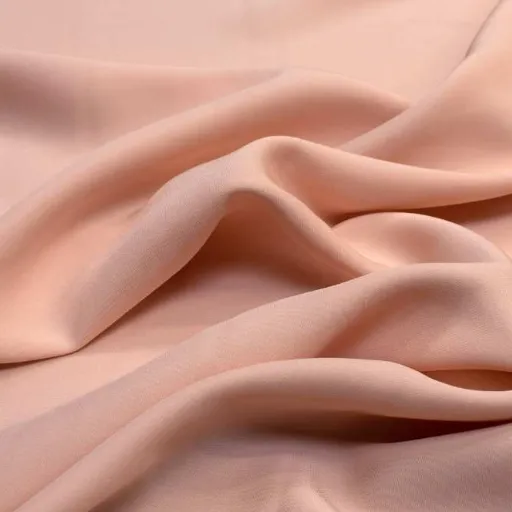
Fashion and Apparel Uses
In the general arena of fashion, rayon and viscose find consideration due to their versatility and mimicry of natural fibers such as silk, cotton, and linen. Most of the fabrics, those from rayon or from viscose, go into dresses, blouses, skirts, and suits. This offers a lightweight option to the wearer of casual-life-days or for occasions. They possess a smooth texture; hence, they are suitable for use in garments that flow nicely and are well suited for a refined appearance.
Comfort stands as one of the landmarks of the use of rayon and viscose in fashion. These materials are soft with a great moisture absorption capacity, therefore best for the warmer climates’ clothing. They can easily absorb any dye; hence, the fabrics have bright and long-living colors that attract many differences in styles and preferences. Because these fabrics tend to be delicate, care has to be exercised in the maintenance of garments made from rayon or viscose. Otherwise, they must sometimes be hand washed or dry-cleaned by a professional.
The presence of these fabrics prevents rayon and viscose from synonymous to casual and formal wear: activewear and loungewear employ them as well! The hallmark of rayon and viscose is that these fabrics maintain an optimum balance of breathable lightness with a stretch factor considered best for garments that try to uphold the principles of comfort and functionality.
Home Textiles and Furnishings
Rayon and viscose are soft, flexible, and aesthetic fabrics widely used in the home textiles and furnishings industry. They go into making curtains, upholstery, and decorative pillows, draping well and coming in many finishes and textures. These textiles can turn a home interior around in terms of looks and feel while adding a discrete touch of luxury. They are inexpensive.
In interior furnishings, rayon and viscose have the advantage of allowing for breathability, hence comfort, especially in the likes of bedsheets and duvet covers. Being good costume imitations of natural fibers, they are further worthy choices for homeowners who prioritize quality and comfort at more reasonable prices. They dye really well and offer colours and patterns that do not fade quickly.
Care Tip: Yet it is necessary to care for your rayon and viscose home textiles if you desire longevity. A few of these materials might react to moisture and temperature changes. Therefore, you will have to wash them carefully. Usually, hand washing and machine washing on a delicate setting are recommended. Hence, they should be kept from harsh detergents. In any case, if you take care of them properly, they can remain a symbol of everlasting elegance and functionality for years to come in all sorts of home environments.
Industrial Applications of Viscose Fabric
The industrial usage of viscose fabric is vast because it possesses the versatility of being manipulated into different uses. Because of its capability to be manipulated into fabrics that mimic natural fibers such as cotton, silk, and wool, it can manufacture high-quality textiles at a much cheaper rate. Industrial usages of viscose include making garments, upholsteries, and home furnishings with an emphasis on its smooth feel and breathability.
Apart from being textile applications, viscose is also filtered into non-woven products like industrial wipes, surgical swabs, and sanitary products. Such materials should absorb and feel soft; this is what is required here. This, donc, gives viscose a role in medical-goods, cleaning, and personal-care industries.
Viscose further finds use in industries requiring raw material from renewable and biodegradable sources. For instance, in tire cord production, packaging industries, and filtration products. Its meshing strength and malleability combined with the eco-worthiness of viscose proven to be a song of one stand, thus standing as an indispensible material in many industries for the performance and environment balance.
Frequently Asked Questions (FAQ)
Q: What is viscose?
A: Viscose can be considered a semi-synthetic fiber because of its being regenerated cellulose derived mostly from wood pulp. Due to its silkiness and excellent draping qualities, it is commonly diversified in the textile industry into apparel and bed sheets.
Q: How is viscose made?
A: The manufacture of viscose involves dissolving cellulose fibers in a chemical solution made from caustic soda and carbon disulfide, possibly. This chemical dissolution produces a viscous solution that is extruded into filaments, which are stretched to form rayon filaments, into which soft and glossy fabrics of our times had been turned.
Q: What are the differences between viscose and other kinds of rayon?
A: While viscose is a fiber under the category of rayon, the other two types of cellulose fiber are modal and lyocell, with the difference being in their manufacturing methods. For example, modal is obtained from the beech tree and coveted for its exceptional softness and absorbency, whereas lyocell, marketed under the trade name Tencel, is produced using a closed-loop process that is said to be environmentally safer.
Q: Is viscose rayon eco-friendly?
A: It depends on whether it is ecological. Historically traditional viscose manufacturing methods have been destructive to the environment. But with companies like Lenzing producing viscose from wood pulp sourced from well-managed forests, especially from eucalyptus trees, using processes that reduce carbon footprints, the implications of sustainable viscose come into play.
Q: Can viscose rayon be dyed easily?
A: Yes, viscose rayon dyes so well, and as a result, it can be dyed in limitless colors and patterns. With this property in hand, dyed and printed viscose fabrics are one of the leading choices for fashion and home textiles.
Q: What are viscose fibers compared to cotton in nature?
A: Viscose rayon is often deemed an alternative to cotton due to its softness and ability to hang down. Technically, cotton is a natural fiber, while viscose is a semi-synthetic fiber made from cellulose, which offers comfort and absorbency on a somewhat similar basis but then insists on completely different upkeep from cotton.
Q: What fabrics are made from viscose rayon?
A: Different types of fabrics made from viscose rayon include challis, twill, and viscose crepe. Each particular fabric has its own distinctive traits, which make them suitable for a variety of clothing and textile products from dresses to bed sheets.
Q: How should viscose rayon be cared for?
A: The viscose rayon should be cared for well. Usually, dry cleaning is suggested, but it can also be gentle cycle machine washed. Air drying is best since a lot of heat and abrasion may harm the fabric and destroy its charming drape and softness.
Q: What benefits does viscose rayon have in textile applications?
A: Viscose rayon has many advantages: it is highly absorbent, silky soft, and moves fluidly, although it is light-weighted and allows for air circulation. Therefore it sees application in fashion and home textiles alike. Also, it is usually blended with other fibers such as spandex to attain better stretch and comfort.
References
- What is Viscose? Understanding this Popular Rayon Type – A detailed explanation of viscose rayon, its production process, and characteristics.
- Reinforced cementitious composite using viscose rayon – A scientific study analyzing the use of viscose rayon fibers in reinforced cementitious composites.
- Rayon unravelled: fashion’s most confusing fibre has a dark past but hopeful future – An article discussing the history, controversies, and future of viscose rayon in the fashion industry.
- Viscose Rayon – A scientific document presenting controlled tests on viscose rayon specimens from different eras.
- Know Your Fiber: Viscose Rayon (aka Bamboo, Viscose) – A blog post exploring the history and properties of viscose rayon, also known as artificial silk.








